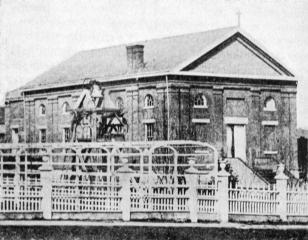|
It
is possible that the first parochial school founded in Iowa City was
also entitled to the honor of being designated properly the first of
its type in the state of Iowa. The birth year of the institution was
1846. This was two years after its founder, the Rev. Anthony Godfert,
came here as the first resident pastor of St. Mary’s church.
He
came in 1844 and had been preceded by the Rev. Samuel Charles
Mazzuchelli, a native of Milan, Italy, the first regularly assigned
priest to become active in the future state of Iowa.
Also
serving before Father Godfert were the Rev. Anthony Pelamourgues and
the Rev. A. G. Alleman. The Godfert school, it is believed, was really
a stepping stone to St. Mary’s school, the modern parochial institution
that blossomed out to become one of the finest of its type in the
Hawkeye commonwealth.
The
school opened the very year that Iowa was
admitted to the Sisterhood
of
States. Its first
home was in the basement of St. Mary's
church.
Miss
Norma O’Connor was the teacher. A few years later, in |
St.
Mary's Catholic Church
as
it was completed in 1863
|
the first lustrum
of the 1850’s, its faculty was several hundred per cent larger.
Aftr
Father Godfert, Fathers B. M. Puet and J. P. McCormick served. Then the
Rev. Mathias Hannon came. In his administration (1853-1855) the faculty
personnel roster carried the names of Miss Ellen McCadden – a
kinswoman, we assume, of Samuel P. McCadden, who was sheriff of Johnson
county some years later.
With
her served Messrs. Martin Doran and Alexander Hill. John Neider
conducted a school where in German was taught, at Linn and Bloomington,
in 1854, but that building was taken over by the Asylum for the Blind.
Enroute
to the St. Mary’s school of today, the promoters and developers
traveled, step by step, to the St. Mary’s free school, the St. Agatha’s
seminary, and the Sisters of Mercy (B.V.M.) school. The
Sisters conducted their early school in Conrad Dunkel’s residence,
between St. Mary’s church and the modern Economy Printing Company the
south part of whose plant occupies the ancient Dunkel site.
Oddly,
that school building became the Humphrey-Moore meat market in after
years. That was a curious metamorphosis. St. Agatha’s Seminary was
located in the present day Burkley Apartment house, across the street,
due west, from the Methodist church, Sister M. Agatha (Hurley) was its
first Sister Superior.
Prof.
Bronson conducted a school in the same era at the intersection of Linn
and Market, where now stands the grocery store and residence of Mrs.
Philip Unrath.
The
Burkley apartment building, owned by Frank P. Burkley, a pioneer hotel
man, whose name is perpetuated by the present day “Imperial”, south of
the campus, on Washington street, was also a hotel building once, as
Ferdinand Haberstroh built it for that purpose, in territorial capital
days. His
wife, Mrs. Mary M. Haberstroh, deeded it to the parish, in 1861, and it
became the Sisters’ property, in 1864. St. Joseph’s Institute, west of
St. Agatha’s was razed in 1892, and on its site and near thereto the
splendid parochial schools of 1952 were duly reared.
The
first St. Mary’s school came in 1892, where the corner stone was laid
on Sunday, September 11. Classes began work the following year, in the
building, and Sisters of St. Francis were their instructors.
The
graded schools of the parish were founded by Sister M.
Etienne
(Fleming) in 1896, and St. Mary’s high, the finest of the Marian group,
came into being, in 1897. The first commencement excercises of the high
school were held in June, 1900.
The
Sisters were not alone in their instructional labors. They early
utilized the skilled services of members of the laity – including such
capable educators as Misses Matie Mueller, Mamie Speidel, Dell Metzger
and Grace Rock, and Homer V. Speidel, long a clothing merchant in Iowa
City. – J.E.R.
Source: "A
Fact A Day About Iowa City." Iowa
City Press-Citizen, 24 Oct. 1952, p. 6
|
